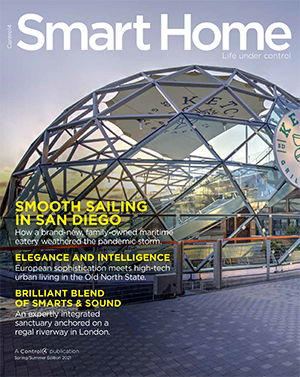Smart Home Technology Allows Seniors to Age in Place
October 15, 2018
Providing peace of mind that loved ones are safe, smart devices are helping people age gracefully in their own homes.
The year 2030 marks an important demographic turning point in U.S. history according to the U.S. Census Bureau’s 2017 National Population Projections. By 2030, all baby boomers will be older than age 65. This will expand the size of the older population so that 1 in every 5 residents will be retirement age.
“The aging of baby boomers means that within just a couple decades, older people are projected to outnumber children for the first time in U.S. history,” says Jonathan Vespa, a demographer with the U.S. Census Bureau. “By 2035, there will be 78.0 million people 65 years and older compared to 76.7 million under the age of 18.”
As the population ages, people of all walks of life are faced with the dilemma of how to best care for their older loved ones. Sure, nursing homes are one solution, but the costs are astronomical. For this reason, many caregivers are exploring ways to enable the elderly to stay at home where they can age with dignity and grace. The Aging in Place movement, also known as Living in Place, focuses on creating a home environment that is safe, comfortable, functional, and is able to adapt to the changing needs of aging family members. There has been a growing interest amongst interior designers and other industry professionals on how to increase safety and accessibility in the home, and they have been exploring new resources to improve daily living and security for this demographic.
As many caregivers and accessibility-focused designers have discovered, smart-home technology can lend a helping hand, enabling seniors to live independently in their homes and provide caregivers with priceless peace of mind—both emotional and financial.
Do you think the older generation isn’t ready for modern technology in their homes? Think again. According to data from the Pew Research Center, four in ten seniors now own smartphones, more than double who owned a smartphone in 2013. Granted, that’s still not the vast majority, but it points toward a deepening comfort level among the elderly for technology.
There’s also been a movement among the smart home industry to make devices simpler to install and to use. Moreover, about any smart home device you buy today can connect to the Internet. This enables caregivers to easily keep tabs on their loved ones, even from miles away. The Internet connection happens so transparently and seamlessly, that it requires no special steps taken by seniors and without any sacrifice of their privacy or independence. Here are some of Internet-enabled products that caregivers and/or interior designers can add to a space in order to provide peace of mind, comfort, and control in the home—many of which are offered by Control4.
SENSORS
Certainly, sensors are an important element of overall safety at home, watching for and reporting break-ins, fire, and flooding. There are many more things sensors can do, though, to ensure personal safety and well-being of stay-at-home seniors. Sensors applied to doors can report when they have left the house and when they have returned. They can also monitor when the doors on medicine cabinets and the refrigerator open and close, so caregivers know if and when their loved ones have taken their medication or eaten.
SURVEILLANCE CAMERAS
Taking monitoring a step further, surveillance cameras provide visual and audible verification of activities in the home. Images and audio can be transmitted in real-time to a caregiver’s smartphone; should the caregiver need to respond to a situation, he or she can speak with their loved one through the camera’s built-in microphone. Wireless cameras can be positioned easily throughout a home, and smart intercoms located at the front door can enable seniors to see and speak with visitors directly from a tablet or phone before letting them in.
SMART LIGHTS AND THERMOSTATS
When mobility declines, having a way to manage a home without excessive effort is key to independent living. Smart lighting keypads can turn select fixtures on and off automatically at certain times of the day, for example, even activating hallway lights at a dim level to make nighttime trips to the bathroom or kitchen safer. When programmed appropriately, smart lighting can also serve as reminders, flashing the kitchen lights when it’s time to take medication or when the mail has been delivered, for example. Buttons on a smart lighting keypad can simplify routines, too. By pressing one button a user can launch a command that turns off every light before bed or activates them all when there’s a knock at the door, for example.
Smart thermostats, meanwhile, ensure the comfort of those who choose to age in place by maintaining preferred temperature settings throughout the day automatically—no fiddling with buttons, dials, or knobs. If a loved one feels too warm or cold, they can adjust the settings directly from a smartphone or tablet.
VOICE-ENABLED HOME CONTROL
When smart products are tied to a home control system that can be controlled by voice commands, aging in place becomes truly effortless. By speaking simple phrases, seniors can manage every aspect of their home environment—lights, temperature, music, video, security, window shades, and more. Another benefit: caregivers can access the system remotely via an Internet connection to ensure the well-being of the house and senior. If the exterior lights are still on after midnight, for example, a caregiver can turn them off.
Aging in place in an environment that’s comfortable, convenient, safe, and easy to manage requires a home design that adapts to the special needs of occupants. Technology is well poised to provide the means to that end. From simple devices like sensors to comprehensive control systems, smart home solutions provide seniors with the tools for independent living.
The year 2030 marks an important demographic turning point in U.S. history according to the U.S. Census Bureau’s 2017 National Population Projections. By 2030, all baby boomers will be older than age 65. This will expand the size of the older population so that 1 in every 5 residents will be retirement age.
“The aging of baby boomers means that within just a couple decades, older people are projected to outnumber children for the first time in U.S. history,” says Jonathan Vespa, a demographer with the U.S. Census Bureau. “By 2035, there will be 78.0 million people 65 years and older compared to 76.7 million under the age of 18.”
As the population ages, people of all walks of life are faced with the dilemma of how to best care for their older loved ones. Sure, nursing homes are one solution, but the costs are astronomical. For this reason, many caregivers are exploring ways to enable the elderly to stay at home where they can age with dignity and grace. The Aging in Place movement, also known as Living in Place, focuses on creating a home environment that is safe, comfortable, functional, and is able to adapt to the changing needs of aging family members. There has been a growing interest amongst interior designers and other industry professionals on how to increase safety and accessibility in the home, and they have been exploring new resources to improve daily living and security for this demographic.
As many caregivers and accessibility-focused designers have discovered, smart-home technology can lend a helping hand, enabling seniors to live independently in their homes and provide caregivers with priceless peace of mind—both emotional and financial.
Do you think the older generation isn’t ready for modern technology in their homes? Think again. According to data from the Pew Research Center, four in ten seniors now own smartphones, more than double who owned a smartphone in 2013. Granted, that’s still not the vast majority, but it points toward a deepening comfort level among the elderly for technology.
There’s also been a movement among the smart home industry to make devices simpler to install and to use. Moreover, about any smart home device you buy today can connect to the Internet. This enables caregivers to easily keep tabs on their loved ones, even from miles away. The Internet connection happens so transparently and seamlessly, that it requires no special steps taken by seniors and without any sacrifice of their privacy or independence. Here are some of Internet-enabled products that caregivers and/or interior designers can add to a space in order to provide peace of mind, comfort, and control in the home—many of which are offered by Control4.
SENSORS
Certainly, sensors are an important element of overall safety at home, watching for and reporting break-ins, fire, and flooding. There are many more things sensors can do, though, to ensure personal safety and well-being of stay-at-home seniors. Sensors applied to doors can report when they have left the house and when they have returned. They can also monitor when the doors on medicine cabinets and the refrigerator open and close, so caregivers know if and when their loved ones have taken their medication or eaten.
SURVEILLANCE CAMERAS
Taking monitoring a step further, surveillance cameras provide visual and audible verification of activities in the home. Images and audio can be transmitted in real-time to a caregiver’s smartphone; should the caregiver need to respond to a situation, he or she can speak with their loved one through the camera’s built-in microphone. Wireless cameras can be positioned easily throughout a home, and smart intercoms located at the front door can enable seniors to see and speak with visitors directly from a tablet or phone before letting them in.
SMART LIGHTS AND THERMOSTATS
When mobility declines, having a way to manage a home without excessive effort is key to independent living. Smart lighting keypads can turn select fixtures on and off automatically at certain times of the day, for example, even activating hallway lights at a dim level to make nighttime trips to the bathroom or kitchen safer. When programmed appropriately, smart lighting can also serve as reminders, flashing the kitchen lights when it’s time to take medication or when the mail has been delivered, for example. Buttons on a smart lighting keypad can simplify routines, too. By pressing one button a user can launch a command that turns off every light before bed or activates them all when there’s a knock at the door, for example.
Smart thermostats, meanwhile, ensure the comfort of those who choose to age in place by maintaining preferred temperature settings throughout the day automatically—no fiddling with buttons, dials, or knobs. If a loved one feels too warm or cold, they can adjust the settings directly from a smartphone or tablet.
VOICE-ENABLED HOME CONTROL
When smart products are tied to a home control system that can be controlled by voice commands, aging in place becomes truly effortless. By speaking simple phrases, seniors can manage every aspect of their home environment—lights, temperature, music, video, security, window shades, and more. Another benefit: caregivers can access the system remotely via an Internet connection to ensure the well-being of the house and senior. If the exterior lights are still on after midnight, for example, a caregiver can turn them off.
Aging in place in an environment that’s comfortable, convenient, safe, and easy to manage requires a home design that adapts to the special needs of occupants. Technology is well poised to provide the means to that end. From simple devices like sensors to comprehensive control systems, smart home solutions provide seniors with the tools for independent living.
Visit a Control4 Certified Showroom to sample incredible smart-home solutions or simply fill out the form below to receive more information about home automation.
We take your privacy seriously and we promise we won't spam you; please see our privacy policy for details. By submitting your information, you are confirming that you are 18 years of age
Thank you
Tags: aging in place atlanta boston chicago dallas denver los-angeles miami new-york-city phoenix salt-lake-city san-francisco smart-home-trends toronto
Category SMART HOME TRENDS 
